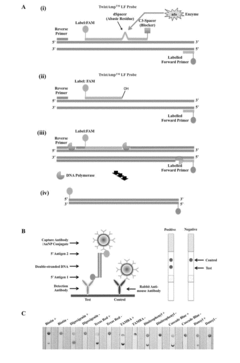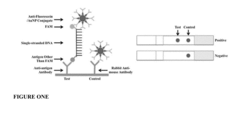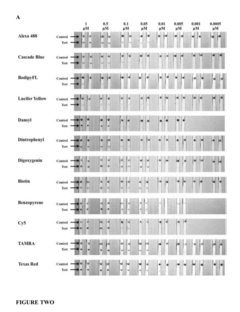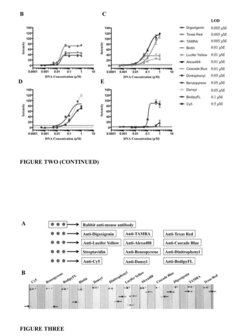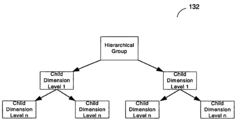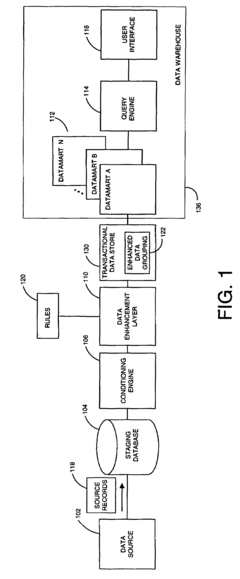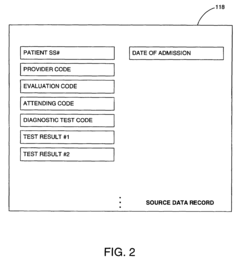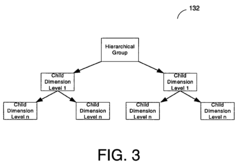Multiplexer Advancements in Healthcare Data Systems
JUL 13, 202510 MIN READ
Generate Your Research Report Instantly with AI Agent
Patsnap Eureka helps you evaluate technical feasibility & market potential.
Healthcare Multiplexer Evolution and Objectives
Multiplexers have played a crucial role in the evolution of healthcare data systems, enabling the efficient management and transmission of vast amounts of medical information. The development of multiplexer technology in healthcare can be traced back to the early 1990s when digital health records began to emerge. Initially, these systems were limited in their capacity to handle multiple data streams simultaneously, leading to bottlenecks in data processing and transmission.
As healthcare organizations increasingly adopted electronic health records (EHRs) and digital imaging technologies, the demand for more sophisticated multiplexing solutions grew exponentially. The early 2000s saw significant advancements in multiplexer design, with the introduction of time-division multiplexing (TDM) and frequency-division multiplexing (FDM) techniques specifically tailored for healthcare applications. These innovations allowed for the concurrent transmission of various types of medical data, including patient vitals, lab results, and diagnostic images, over a single communication channel.
The advent of high-speed internet and cloud computing in the late 2000s further accelerated the evolution of healthcare multiplexers. This technological leap enabled the development of more advanced multiplexing techniques, such as wavelength-division multiplexing (WDM) and statistical multiplexing, which dramatically increased data throughput and improved the overall efficiency of healthcare information systems.
In recent years, the focus of multiplexer advancements in healthcare has shifted towards addressing the challenges posed by the exponential growth of data generated by wearable devices, remote patient monitoring systems, and artificial intelligence-driven diagnostic tools. The integration of edge computing and 5G technologies has paved the way for real-time multiplexing and demultiplexing of massive datasets, enabling faster and more accurate clinical decision-making.
Looking ahead, the primary objectives for healthcare multiplexer technology include enhancing data security and privacy, improving interoperability between disparate healthcare systems, and optimizing bandwidth utilization in resource-constrained environments. Researchers are exploring novel approaches such as quantum multiplexing and AI-driven adaptive multiplexing algorithms to meet these challenges and support the next generation of personalized and precision medicine applications.
As healthcare continues to digitize and data volumes grow, multiplexer technology will play an increasingly critical role in ensuring the seamless flow of information across the healthcare ecosystem. The ongoing evolution of this technology aims to support more efficient, accurate, and timely patient care while enabling healthcare providers to harness the full potential of big data analytics and artificial intelligence in clinical practice.
As healthcare organizations increasingly adopted electronic health records (EHRs) and digital imaging technologies, the demand for more sophisticated multiplexing solutions grew exponentially. The early 2000s saw significant advancements in multiplexer design, with the introduction of time-division multiplexing (TDM) and frequency-division multiplexing (FDM) techniques specifically tailored for healthcare applications. These innovations allowed for the concurrent transmission of various types of medical data, including patient vitals, lab results, and diagnostic images, over a single communication channel.
The advent of high-speed internet and cloud computing in the late 2000s further accelerated the evolution of healthcare multiplexers. This technological leap enabled the development of more advanced multiplexing techniques, such as wavelength-division multiplexing (WDM) and statistical multiplexing, which dramatically increased data throughput and improved the overall efficiency of healthcare information systems.
In recent years, the focus of multiplexer advancements in healthcare has shifted towards addressing the challenges posed by the exponential growth of data generated by wearable devices, remote patient monitoring systems, and artificial intelligence-driven diagnostic tools. The integration of edge computing and 5G technologies has paved the way for real-time multiplexing and demultiplexing of massive datasets, enabling faster and more accurate clinical decision-making.
Looking ahead, the primary objectives for healthcare multiplexer technology include enhancing data security and privacy, improving interoperability between disparate healthcare systems, and optimizing bandwidth utilization in resource-constrained environments. Researchers are exploring novel approaches such as quantum multiplexing and AI-driven adaptive multiplexing algorithms to meet these challenges and support the next generation of personalized and precision medicine applications.
As healthcare continues to digitize and data volumes grow, multiplexer technology will play an increasingly critical role in ensuring the seamless flow of information across the healthcare ecosystem. The ongoing evolution of this technology aims to support more efficient, accurate, and timely patient care while enabling healthcare providers to harness the full potential of big data analytics and artificial intelligence in clinical practice.
Market Demand Analysis for Healthcare Data Systems
The healthcare data systems market is experiencing a significant surge in demand, driven by the increasing digitization of healthcare services and the growing need for efficient data management in medical facilities. This demand is further amplified by the rising adoption of electronic health records (EHRs), telemedicine, and the integration of artificial intelligence in healthcare diagnostics and treatment planning.
The global healthcare IT market, which includes data management systems, is projected to grow at a compound annual growth rate (CAGR) of over 10% in the coming years. This growth is primarily fueled by the need for improved patient care, enhanced operational efficiency, and the push for value-based healthcare models. Multiplexers, as key components in healthcare data systems, play a crucial role in managing and transmitting large volumes of patient data securely and efficiently.
One of the primary drivers of market demand is the increasing focus on interoperability in healthcare systems. Healthcare providers are seeking solutions that can seamlessly integrate data from various sources, including different departments within a hospital, multiple healthcare facilities, and even patient-generated data from wearable devices. This integration requires advanced multiplexing technologies to handle diverse data streams and ensure real-time data availability.
The COVID-19 pandemic has further accelerated the demand for robust healthcare data systems. The sudden surge in telemedicine and remote patient monitoring has created a need for more sophisticated data management and transmission solutions. Multiplexers capable of handling high-bandwidth, low-latency data transmission are becoming essential for supporting these remote healthcare services.
Another significant factor driving market demand is the increasing emphasis on data security and privacy in healthcare. With the rise in cyber threats and stringent regulatory requirements like HIPAA in the United States and GDPR in Europe, healthcare providers are seeking advanced data systems that can ensure the confidentiality and integrity of patient information. Multiplexers with enhanced encryption capabilities and secure data routing features are in high demand to meet these security requirements.
The trend towards personalized medicine and precision healthcare is also contributing to the growing market for advanced healthcare data systems. These approaches require the analysis of vast amounts of patient data, including genomic information, which necessitates high-performance data management and processing capabilities. Multiplexers that can efficiently handle and route large datasets are becoming increasingly important in supporting these cutting-edge medical practices.
In conclusion, the market demand for advanced multiplexers in healthcare data systems is robust and growing. The convergence of factors such as digital transformation in healthcare, the need for interoperability, increased focus on data security, and the emergence of data-driven medical practices is driving this demand. As healthcare continues to evolve, the role of sophisticated data management technologies, including advanced multiplexers, will become increasingly critical in delivering efficient, secure, and high-quality patient care.
The global healthcare IT market, which includes data management systems, is projected to grow at a compound annual growth rate (CAGR) of over 10% in the coming years. This growth is primarily fueled by the need for improved patient care, enhanced operational efficiency, and the push for value-based healthcare models. Multiplexers, as key components in healthcare data systems, play a crucial role in managing and transmitting large volumes of patient data securely and efficiently.
One of the primary drivers of market demand is the increasing focus on interoperability in healthcare systems. Healthcare providers are seeking solutions that can seamlessly integrate data from various sources, including different departments within a hospital, multiple healthcare facilities, and even patient-generated data from wearable devices. This integration requires advanced multiplexing technologies to handle diverse data streams and ensure real-time data availability.
The COVID-19 pandemic has further accelerated the demand for robust healthcare data systems. The sudden surge in telemedicine and remote patient monitoring has created a need for more sophisticated data management and transmission solutions. Multiplexers capable of handling high-bandwidth, low-latency data transmission are becoming essential for supporting these remote healthcare services.
Another significant factor driving market demand is the increasing emphasis on data security and privacy in healthcare. With the rise in cyber threats and stringent regulatory requirements like HIPAA in the United States and GDPR in Europe, healthcare providers are seeking advanced data systems that can ensure the confidentiality and integrity of patient information. Multiplexers with enhanced encryption capabilities and secure data routing features are in high demand to meet these security requirements.
The trend towards personalized medicine and precision healthcare is also contributing to the growing market for advanced healthcare data systems. These approaches require the analysis of vast amounts of patient data, including genomic information, which necessitates high-performance data management and processing capabilities. Multiplexers that can efficiently handle and route large datasets are becoming increasingly important in supporting these cutting-edge medical practices.
In conclusion, the market demand for advanced multiplexers in healthcare data systems is robust and growing. The convergence of factors such as digital transformation in healthcare, the need for interoperability, increased focus on data security, and the emergence of data-driven medical practices is driving this demand. As healthcare continues to evolve, the role of sophisticated data management technologies, including advanced multiplexers, will become increasingly critical in delivering efficient, secure, and high-quality patient care.
Current Multiplexer Technology in Healthcare
In healthcare data systems, multiplexers play a crucial role in managing and transmitting large volumes of patient information efficiently. Current multiplexer technology in healthcare focuses on high-speed data transmission, enhanced security measures, and improved integration with existing medical devices and systems.
One of the primary advancements in multiplexer technology for healthcare is the development of high-bandwidth multiplexers capable of handling the increasing amount of data generated by modern medical equipment. These multiplexers can simultaneously process and transmit data from multiple sources, such as patient monitors, imaging devices, and electronic health records, without compromising data integrity or introducing significant latency.
Security features have become a paramount concern in healthcare data systems. Current multiplexer technology incorporates advanced encryption protocols and secure data transmission methods to ensure patient privacy and comply with stringent healthcare regulations like HIPAA. Some multiplexers now include built-in firewalls and intrusion detection systems to prevent unauthorized access and data breaches.
Interoperability is another key focus of current multiplexer technology in healthcare. Modern multiplexers are designed to seamlessly integrate with a wide range of medical devices and hospital information systems, supporting various communication protocols and data formats. This compatibility ensures smooth data flow across different departments and facilities, enabling better coordination of patient care.
Adaptive multiplexing techniques have been introduced to optimize data transmission in healthcare settings. These systems can dynamically allocate bandwidth based on the priority and urgency of different data streams, ensuring that critical patient information is transmitted without delay while managing less time-sensitive data efficiently.
Miniaturization and power efficiency have also been significant areas of improvement in multiplexer technology for healthcare. Compact, low-power multiplexers are now available, making them suitable for use in portable medical devices and remote patient monitoring systems. This advancement has contributed to the growth of telemedicine and home healthcare solutions.
Error detection and correction capabilities have been enhanced in current multiplexer systems to maintain data accuracy in healthcare applications. Advanced algorithms can identify and rectify transmission errors in real-time, ensuring the integrity of vital patient data and reducing the risk of misdiagnosis or treatment errors due to corrupted information.
Cloud-compatible multiplexer solutions have emerged to support the growing trend of cloud-based healthcare data management. These systems can securely transmit data to cloud storage and processing platforms, facilitating remote access to patient information and enabling advanced analytics for population health management and clinical decision support.
One of the primary advancements in multiplexer technology for healthcare is the development of high-bandwidth multiplexers capable of handling the increasing amount of data generated by modern medical equipment. These multiplexers can simultaneously process and transmit data from multiple sources, such as patient monitors, imaging devices, and electronic health records, without compromising data integrity or introducing significant latency.
Security features have become a paramount concern in healthcare data systems. Current multiplexer technology incorporates advanced encryption protocols and secure data transmission methods to ensure patient privacy and comply with stringent healthcare regulations like HIPAA. Some multiplexers now include built-in firewalls and intrusion detection systems to prevent unauthorized access and data breaches.
Interoperability is another key focus of current multiplexer technology in healthcare. Modern multiplexers are designed to seamlessly integrate with a wide range of medical devices and hospital information systems, supporting various communication protocols and data formats. This compatibility ensures smooth data flow across different departments and facilities, enabling better coordination of patient care.
Adaptive multiplexing techniques have been introduced to optimize data transmission in healthcare settings. These systems can dynamically allocate bandwidth based on the priority and urgency of different data streams, ensuring that critical patient information is transmitted without delay while managing less time-sensitive data efficiently.
Miniaturization and power efficiency have also been significant areas of improvement in multiplexer technology for healthcare. Compact, low-power multiplexers are now available, making them suitable for use in portable medical devices and remote patient monitoring systems. This advancement has contributed to the growth of telemedicine and home healthcare solutions.
Error detection and correction capabilities have been enhanced in current multiplexer systems to maintain data accuracy in healthcare applications. Advanced algorithms can identify and rectify transmission errors in real-time, ensuring the integrity of vital patient data and reducing the risk of misdiagnosis or treatment errors due to corrupted information.
Cloud-compatible multiplexer solutions have emerged to support the growing trend of cloud-based healthcare data management. These systems can securely transmit data to cloud storage and processing platforms, facilitating remote access to patient information and enabling advanced analytics for population health management and clinical decision support.
Existing Multiplexer Solutions for Healthcare Data
01 Efficient data multiplexing techniques
Various techniques are employed to improve the efficiency of data multiplexing in digital systems. These include advanced multiplexer designs, optimized switching mechanisms, and improved signal routing strategies. Such techniques aim to reduce latency, increase throughput, and enhance overall system performance in data processing applications.- Efficient data multiplexing techniques: Various techniques are employed to improve the efficiency of data multiplexing in digital systems. These include advanced scheduling algorithms, parallel processing, and optimized data routing mechanisms. Such techniques help reduce latency, increase throughput, and improve overall system performance in multiplexed data processing environments.
- Hardware-based multiplexer optimization: Hardware-level optimizations for multiplexers focus on improving data processing efficiency through specialized circuit designs. These may include high-speed switching fabrics, pipelined architectures, and custom logic implementations. Such hardware enhancements can significantly boost the performance of multiplexer-based systems in data-intensive applications.
- Data compression and encoding for multiplexing: Implementing data compression and encoding techniques in multiplexer systems can greatly enhance data processing efficiency. These methods reduce the amount of data that needs to be transmitted or processed, leading to improved bandwidth utilization and faster processing times. Advanced algorithms are used to compress and encode data without significant loss of information.
- Adaptive multiplexing strategies: Adaptive multiplexing strategies involve dynamically adjusting multiplexer configurations based on real-time data flow and system conditions. These strategies can include load balancing, priority-based scheduling, and dynamic channel allocation. By adapting to changing conditions, these systems can maintain optimal data processing efficiency across various operational scenarios.
- Integration of multiplexers with advanced processing units: Integrating multiplexers with advanced processing units, such as FPGAs or specialized ASICs, can significantly enhance data processing efficiency. This integration allows for more complex data manipulation, parallel processing, and real-time analysis directly within the multiplexing system. It enables sophisticated data handling capabilities while maintaining high throughput rates.
02 High-speed data processing architectures
Innovative architectures are developed to support high-speed data processing in multiplexer systems. These designs focus on parallel processing, pipelined structures, and optimized data flow paths. By implementing these architectures, multiplexers can handle larger volumes of data with improved efficiency and reduced processing time.Expand Specific Solutions03 Advanced encoding and compression techniques
Multiplexer efficiency is enhanced through the use of advanced encoding and compression algorithms. These techniques reduce the amount of data that needs to be processed and transmitted, leading to improved overall system performance. Implementations may include adaptive encoding schemes and context-aware compression methods.Expand Specific Solutions04 Intelligent scheduling and resource allocation
Efficient multiplexer operation is achieved through intelligent scheduling algorithms and dynamic resource allocation. These approaches optimize the use of available processing resources, manage data priorities, and balance workloads across multiple channels. Such techniques result in improved throughput and reduced latency in data processing tasks.Expand Specific Solutions05 Error detection and correction mechanisms
To maintain data integrity and processing efficiency, advanced error detection and correction mechanisms are implemented in multiplexer systems. These include forward error correction, cyclic redundancy checks, and adaptive error handling techniques. By minimizing data corruption and retransmission, these mechanisms contribute to overall system reliability and performance.Expand Specific Solutions
Key Players in Healthcare Multiplexer Industry
The healthcare data systems multiplexer market is in a growth phase, driven by increasing digitization in healthcare and the need for efficient data management. The market size is expanding rapidly, with projections indicating significant growth in the coming years. Technologically, multiplexer advancements are progressing swiftly, with major players like Qualcomm, Samsung Electronics, and Siemens Medical Solutions leading innovation. These companies are developing more sophisticated, high-capacity multiplexers to handle the growing volume and complexity of healthcare data. Other key contributors include Philips, Intel, and Micron Technology, who are integrating advanced multiplexing technologies into their healthcare solutions, enhancing data processing capabilities and system interoperability.
Siemens Medical Solutions USA, Inc.
Technical Solution: Siemens Medical Solutions has developed advanced multiplexing technologies for healthcare data systems, focusing on improving data throughput and reducing latency in medical imaging and diagnostics. Their solution incorporates high-speed analog multiplexers and demultiplexers to efficiently manage multiple data streams from various medical devices. The system utilizes time-division multiplexing (TDM) techniques to transmit multiple signals over a single channel, significantly increasing bandwidth utilization[1]. Additionally, they have implemented wavelength-division multiplexing (WDM) in fiber-optic networks to enhance data transfer speeds between medical facilities, enabling real-time collaboration and telemedicine applications[3]. Siemens' multiplexer advancements also include intelligent routing algorithms that prioritize critical patient data, ensuring timely delivery of vital information to healthcare providers[5].
Strengths: Improved data throughput, reduced latency, and efficient bandwidth utilization. Weaknesses: May require significant infrastructure upgrades and specialized training for healthcare IT staff.
Koninklijke Philips NV
Technical Solution: Philips has pioneered multiplexer advancements in healthcare data systems through their HealthSuite Digital Platform. This cloud-based solution incorporates advanced multiplexing techniques to manage and process vast amounts of patient data from various sources. The platform utilizes frequency-division multiplexing (FDM) to separate different data streams, allowing for simultaneous transmission of multiple types of medical information[2]. Philips has also implemented statistical multiplexing to dynamically allocate bandwidth based on data priority and urgency, optimizing network resources in healthcare settings[4]. Their system includes AI-driven demultiplexing algorithms that can efficiently sort and categorize incoming data, facilitating rapid analysis and decision-making for healthcare professionals[6].
Strengths: Scalable cloud-based solution, AI-enhanced data processing, and optimized resource allocation. Weaknesses: Potential data security concerns and dependence on reliable internet connectivity.
Core Innovations in Healthcare Multiplexers
Multiplex Lateral Flow Devices and Assays
PatentInactiveUS20180319657A1
Innovation
- The development of a lateral flow device with multiple binding molecule populations, each with specific binding specificity and minimal cross-reactivity, arranged in a spatially separated format to form detectable signaling complexes, allowing for the simultaneous detection of multiple analytes with reduced reagent consumption and improved sensitivity.
System and method for multi-dimensional extension of database information
PatentActiveUS7707045B2
Innovation
- A system and method for multidimensional extension of database information using a data enhancement layer that prepares and organizes data into logical structures before storage, allowing for pre-grouping of relationships and attributes, enabling more powerful and flexible analytics and efficient querying.
Data Privacy and Security Considerations
As healthcare data systems continue to evolve, the integration of advanced multiplexer technologies brings forth critical considerations regarding data privacy and security. The increasing volume and complexity of healthcare data necessitate robust protection mechanisms to safeguard sensitive patient information. Multiplexers, while enhancing data transmission efficiency, also introduce potential vulnerabilities that must be addressed.
One primary concern is the risk of unauthorized access to multiplexed data streams. As multiple data channels are combined into a single transmission, any breach could potentially expose a larger volume of sensitive information. To mitigate this risk, healthcare organizations must implement strong encryption protocols specifically designed for multiplexed data. These encryption methods should be capable of securing individual data channels within the multiplexed stream, ensuring that even if one channel is compromised, others remain protected.
Another crucial aspect is the need for granular access control mechanisms. With multiplexed data systems, it becomes more challenging to manage user permissions across various data streams. Implementing role-based access control (RBAC) systems that are compatible with multiplexed architectures is essential. These systems should allow for fine-tuned permissions, ensuring that healthcare professionals only have access to the specific data channels relevant to their roles and responsibilities.
Data integrity is another critical concern in multiplexed healthcare systems. The process of multiplexing and demultiplexing data introduces additional points where data corruption or manipulation could occur. To address this, advanced error detection and correction algorithms must be integrated into the multiplexing process. These algorithms should be capable of identifying and rectifying data inconsistencies in real-time, maintaining the accuracy and reliability of healthcare information.
Compliance with healthcare data protection regulations, such as HIPAA in the United States or GDPR in Europe, becomes more complex in multiplexed environments. Healthcare organizations must ensure that their multiplexer systems are designed with built-in compliance features. This includes comprehensive audit trails that track data access and transmission across all multiplexed channels, as well as mechanisms for data anonymization and pseudonymization when necessary.
The physical security of multiplexer hardware is also a crucial consideration. As these devices become central points for data aggregation and transmission, they represent high-value targets for potential attackers. Implementing robust physical security measures, including secure installation locations, tamper-evident seals, and continuous monitoring systems, is essential to protect against physical breaches.
In conclusion, while multiplexer advancements offer significant benefits for healthcare data systems, they also introduce new challenges in data privacy and security. Addressing these challenges requires a multifaceted approach, combining advanced encryption, granular access control, data integrity measures, regulatory compliance features, and physical security enhancements. As healthcare organizations adopt these technologies, ongoing assessment and adaptation of security measures will be crucial to maintain the confidentiality, integrity, and availability of sensitive healthcare data.
One primary concern is the risk of unauthorized access to multiplexed data streams. As multiple data channels are combined into a single transmission, any breach could potentially expose a larger volume of sensitive information. To mitigate this risk, healthcare organizations must implement strong encryption protocols specifically designed for multiplexed data. These encryption methods should be capable of securing individual data channels within the multiplexed stream, ensuring that even if one channel is compromised, others remain protected.
Another crucial aspect is the need for granular access control mechanisms. With multiplexed data systems, it becomes more challenging to manage user permissions across various data streams. Implementing role-based access control (RBAC) systems that are compatible with multiplexed architectures is essential. These systems should allow for fine-tuned permissions, ensuring that healthcare professionals only have access to the specific data channels relevant to their roles and responsibilities.
Data integrity is another critical concern in multiplexed healthcare systems. The process of multiplexing and demultiplexing data introduces additional points where data corruption or manipulation could occur. To address this, advanced error detection and correction algorithms must be integrated into the multiplexing process. These algorithms should be capable of identifying and rectifying data inconsistencies in real-time, maintaining the accuracy and reliability of healthcare information.
Compliance with healthcare data protection regulations, such as HIPAA in the United States or GDPR in Europe, becomes more complex in multiplexed environments. Healthcare organizations must ensure that their multiplexer systems are designed with built-in compliance features. This includes comprehensive audit trails that track data access and transmission across all multiplexed channels, as well as mechanisms for data anonymization and pseudonymization when necessary.
The physical security of multiplexer hardware is also a crucial consideration. As these devices become central points for data aggregation and transmission, they represent high-value targets for potential attackers. Implementing robust physical security measures, including secure installation locations, tamper-evident seals, and continuous monitoring systems, is essential to protect against physical breaches.
In conclusion, while multiplexer advancements offer significant benefits for healthcare data systems, they also introduce new challenges in data privacy and security. Addressing these challenges requires a multifaceted approach, combining advanced encryption, granular access control, data integrity measures, regulatory compliance features, and physical security enhancements. As healthcare organizations adopt these technologies, ongoing assessment and adaptation of security measures will be crucial to maintain the confidentiality, integrity, and availability of sensitive healthcare data.
Interoperability Standards for Healthcare Systems
Interoperability standards play a crucial role in advancing healthcare data systems, particularly in the context of multiplexer advancements. These standards ensure seamless communication and data exchange between various healthcare systems, devices, and applications, ultimately improving patient care and operational efficiency.
The Health Level Seven International (HL7) standards, including HL7 Version 2 and HL7 FHIR (Fast Healthcare Interoperability Resources), have become widely adopted in the healthcare industry. HL7 FHIR, in particular, has gained significant traction due to its modern, web-based approach to data exchange. It leverages RESTful APIs and JSON/XML formats, making it easier for developers to implement and integrate with existing systems.
Another important standard is DICOM (Digital Imaging and Communications in Medicine), which focuses on the exchange of medical imaging data. DICOM has been instrumental in enabling the interoperability of various imaging modalities and Picture Archiving and Communication Systems (PACS).
The Integrating the Healthcare Enterprise (IHE) initiative has also contributed significantly to healthcare interoperability. IHE profiles provide implementation guidelines for existing standards, ensuring consistent interpretation and application across different systems and vendors.
In recent years, there has been a growing emphasis on patient-centric interoperability standards. The SMART on FHIR framework, for instance, combines HL7 FHIR with OAuth 2.0 authentication to enable secure, patient-authorized access to health data across different applications and platforms.
As multiplexer technology advances in healthcare data systems, these interoperability standards are evolving to accommodate increased data throughput and complexity. For example, the latest versions of HL7 FHIR include support for bulk data transfer and real-time data streaming, which are essential for handling the large volumes of data generated by modern healthcare systems.
The adoption of these standards has led to the development of health information exchanges (HIEs) and nationwide health information networks. These initiatives aim to create a seamless flow of patient data across different healthcare providers, improving care coordination and reducing redundant tests and procedures.
However, challenges remain in achieving full interoperability across healthcare systems. Legacy systems, varying levels of standard adoption, and concerns about data privacy and security continue to pose obstacles. Ongoing efforts are focused on addressing these challenges through improved standardization, enhanced security protocols, and increased collaboration among healthcare stakeholders.
The Health Level Seven International (HL7) standards, including HL7 Version 2 and HL7 FHIR (Fast Healthcare Interoperability Resources), have become widely adopted in the healthcare industry. HL7 FHIR, in particular, has gained significant traction due to its modern, web-based approach to data exchange. It leverages RESTful APIs and JSON/XML formats, making it easier for developers to implement and integrate with existing systems.
Another important standard is DICOM (Digital Imaging and Communications in Medicine), which focuses on the exchange of medical imaging data. DICOM has been instrumental in enabling the interoperability of various imaging modalities and Picture Archiving and Communication Systems (PACS).
The Integrating the Healthcare Enterprise (IHE) initiative has also contributed significantly to healthcare interoperability. IHE profiles provide implementation guidelines for existing standards, ensuring consistent interpretation and application across different systems and vendors.
In recent years, there has been a growing emphasis on patient-centric interoperability standards. The SMART on FHIR framework, for instance, combines HL7 FHIR with OAuth 2.0 authentication to enable secure, patient-authorized access to health data across different applications and platforms.
As multiplexer technology advances in healthcare data systems, these interoperability standards are evolving to accommodate increased data throughput and complexity. For example, the latest versions of HL7 FHIR include support for bulk data transfer and real-time data streaming, which are essential for handling the large volumes of data generated by modern healthcare systems.
The adoption of these standards has led to the development of health information exchanges (HIEs) and nationwide health information networks. These initiatives aim to create a seamless flow of patient data across different healthcare providers, improving care coordination and reducing redundant tests and procedures.
However, challenges remain in achieving full interoperability across healthcare systems. Legacy systems, varying levels of standard adoption, and concerns about data privacy and security continue to pose obstacles. Ongoing efforts are focused on addressing these challenges through improved standardization, enhanced security protocols, and increased collaboration among healthcare stakeholders.
Unlock deeper insights with Patsnap Eureka Quick Research — get a full tech report to explore trends and direct your research. Try now!
Generate Your Research Report Instantly with AI Agent
Supercharge your innovation with Patsnap Eureka AI Agent Platform!
